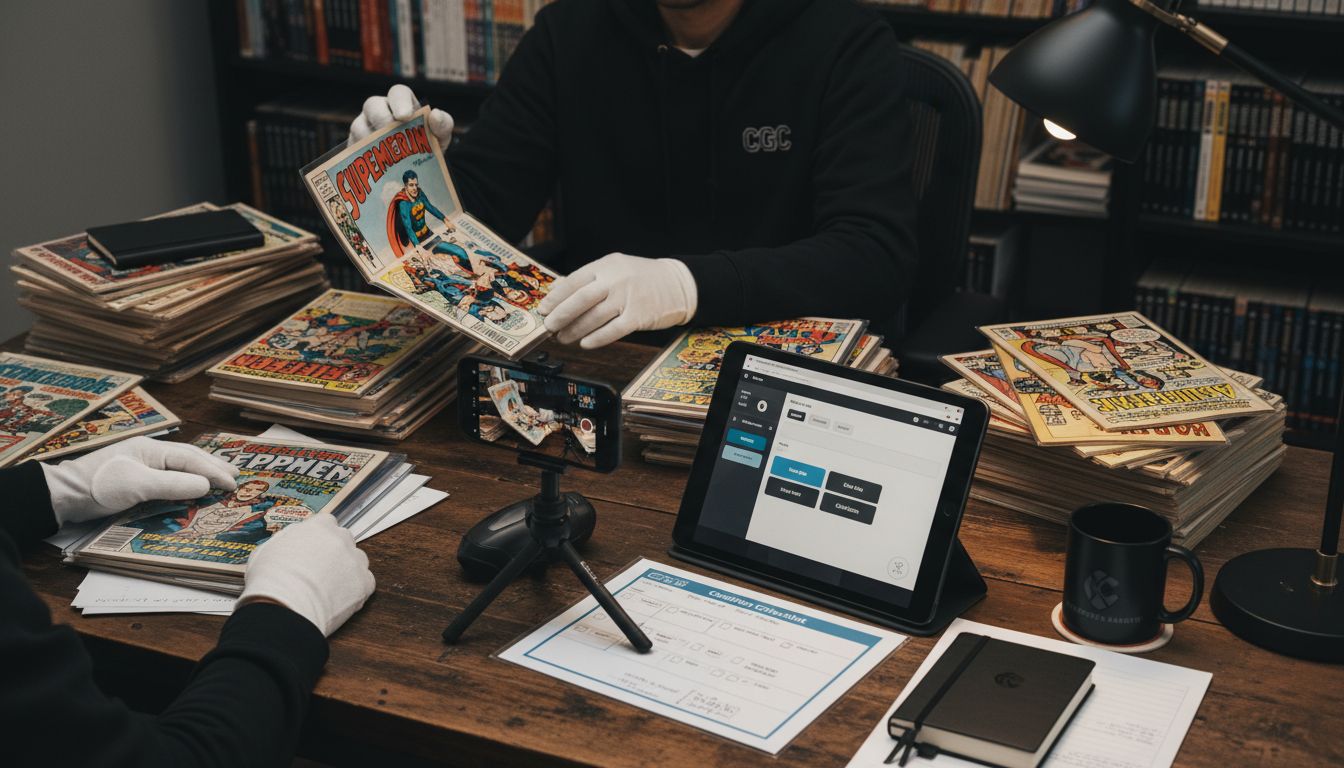Creating a Comics Archive: Step-by-Step Guide for Collectors
Did you know nearly 40 percent of comic collectors lose track of valuable issues due to poor organization? A growing collection can quickly become an overwhelming mess without a clear system. Setting focused goals and using smart strategies turns a simple hobby into a rewarding archive. This guide reveals practical tips to help you preserve, catalog, and organize your comics so every issue stays protected and easy to find.
Table of Contents
- Step 1: Define Your Comics Archive Goals
- Step 2: Select And Catalog Your Comics
- Step 3: Choose Suitable Storage Solutions
- Step 4: Organize Comics Systematically
- Step 5: Verify And Maintain Archive Quality
Quick Summary
| Key Point | Explanation |
|---|---|
| 1. Define clear archive goals | Establish your key motivations for collecting to create focus and direction for your archive strategy. |
| 2. Use digital cataloging tools | Leverage technology to efficiently document comic details and track your collection’s growth with precise entries. |
| 3. Select appropriate storage solutions | Choose archival-quality materials and maintain climate stability to protect your comics from damage over time. |
| 4. Organize systematically | Group comics by various criteria to ensure easy access and better tracking of your entire collection. |
| 5. Regularly maintain your archive | Conduct frequent inspections and adjust storage conditions to preserve the condition and value of your comics. |
Step 1: Define your comics archive goals
Defining clear objectives transforms your comic book collection from a random assortment into a purposeful and organized archive. Your goals will guide every decision about preservation, categorization, and expansion of your collection.
Start by asking yourself what truly motivates your collection. Are you collecting for investment potential? Personal nostalgia? Completionist passion for specific series or artists? According to 8 Essential Reads for Comics Collectors’ Education, understanding your core motivation helps create a focused strategy.
Research from Comic Collector Live suggests creating specific tracking objectives like documenting your entire collection inventory, establishing wishlists for missing issues, and researching potential library expansions. This approach helps you move from casual collecting to systematic archiving.
Your goals might include:
Here’s a comparison of common comic book archive goals and their key focus areas:
| Archive Goal | Primary Focus | Typical Actions |
|---|---|---|
| Complete a series | Cataloging Tracking |
Build wishlists Track missing issues |
| Preserve rare editions | Condition Protection |
Use archival storage Document provenance |
| Value documentation | Appraisal Inventory |
Record condition Research market values |
| Comprehensive catalog | Organization Access |
Create digital logs Take photographs |
| Artist/creator collection | Classification | Sort by artist Research credits |
- Collecting all issues from a particular comic book series
- Preserving first edition or rare prints
- Documenting the condition and value of each comic
- Creating a comprehensive digital or physical catalog
Nichibles recommends classifying comics by manufacturer, type, and condition to effectively manage your collection. This means thinking beyond simple accumulation and towards strategic curation.
Pro Tip: Be realistic about your goals. Start small and build your archive gradually to maintain enthusiasm and prevent overwhelm.
Once you have defined your archive goals, you are ready to move forward with systematic collection management. The next step will help you develop a structured approach to tracking and organizing your growing comic book collection.
Step 2: Select and catalog your comics
Selecting and cataloging your comics transforms your collection from a random group of issues into a meticulously organized archive. This step helps you understand what you own, identify valuable pieces, and track your collection’s growth with precision.
Start by gathering all your comics in one place. Pull them from shelves, boxes, and storage areas. According to How to Care for Comics: Essential Tips for Preservation, handling your comics carefully during this process prevents potential damage.
Research from CLZ Comics suggests using digital tools that simplify comic cataloging. These platforms allow you to scan barcodes or search by title, automatically capturing issue details, cover art, and creator information. Modern collectors can leverage technology to streamline their archival process.
When cataloging, record key information for each comic:
- Issue number and title
- Publication date
- Publisher
- Artist and writer credits
- Current condition
- Estimated value
- Purchase date and location
iCollect Everything recommends tracking not just owned comics but also your wishlist. This approach helps you identify gaps in your collection and plan future acquisitions strategically.
Pro Tip: Take clear photographs of each comic during cataloging. Visual documentation serves as an excellent backup and can help with insurance or potential sales.

Now that you have started cataloging your collection, you are ready to develop a systematic storage and preservation strategy. The next step will focus on protecting your comics and maintaining their condition for years to come.
Step 3: Choose suitable storage solutions
Choosing the right storage solutions is crucial for preserving the condition and value of your comic book collection. Your goal is to create a protective environment that shields your comics from potential damage and degradation.
According to the How to Care for Comics: Essential Tips for Preservation, the key to proper comic storage lies in understanding environmental risks. The Library of Congress recommends storing comics in a cool, dry, and stable environment while avoiding extreme locations like attics and basements.
Start by selecting appropriate storage containers. Archival quality comic book bags and boards provide essential protection against dust, moisture, and physical wear. Space Station suggests using bookends or magazine files to prevent comics from slumping and maintain their structural integrity.
Consider these storage options:
- Acid free comic book boxes
- Protective mylar sleeves
- Comic book binders
- Rotating magazine racks
- Climate controlled display cabinets
Research indicates that temperature and humidity are critical factors. Maintain a consistent environment around 65 to 70 degrees Fahrenheit with 50 percent humidity to prevent paper degradation. Avoid direct sunlight and areas with significant temperature fluctuations.
Pro Tip: Rotate your stored comics periodically to prevent spine stress and ensure even preservation.
With your storage solutions in place, you are now ready to implement a systematic approach to comic book preservation and display.
Step 4: Organize comics systematically
Organizing your comic book collection systematically transforms a random assortment of issues into a well structured archive. This critical step ensures you can easily locate specific comics and understand the full scope of your collection.
Modern digital tools make systematic organization easier than ever. How to Find Obscure Comics: A Complete Step-by-Step Guide highlights the importance of strategic cataloging for collectors.
Research from Whakoom suggests using digital platforms that allow quick addition of comics with a single click. CLZ Comics provides a comprehensive system for organizing comics by series, issue number, and multiple other criteria.
Consider these organizational strategies:
- Group comics by publisher
- Arrange by publication date
- Sort alphabetically by series title
- Categorize by genre or storyline
- Create subcategories for special editions
Digital cataloging platforms offer advanced features like tracking value, condition, and even managing your wishlist. These tools help you maintain a comprehensive overview of your collection without manual record keeping.
Pro Tip: Develop a consistent labeling system. Use clear identifiers like publisher abbreviations and issue numbers to streamline your organizational process.
With a systematic approach in place, you are now prepared to develop strategies for preserving and potentially displaying your carefully organized comic book collection.
Step 5: Verify and maintain archive quality
Verifying and maintaining your comic book archive is a critical step that protects your collection’s long term value and physical condition. This process goes beyond simple storage and requires consistent attention and careful handling.
How to Care for Comics: Essential Tips for Preservation provides crucial insights into maintaining comic book integrity. The Library of Congress emphasizes the importance of proper handling techniques that prevent potential damage.
Start with fundamental preservation practices. Always handle comics with clean hands and work in a clean environment. Avoid using paper clips or rubber bands that can cause permanent creasing or tearing. JiYu Comic Book Collecting recommends controlling environmental factors like temperature and humidity to prevent discoloration and potential mold growth.
Key maintenance strategies include:
- Regular visual inspections for damage
- Monitoring storage environment conditions
- Using acid free protective materials
- Checking for signs of degradation
- Maintaining consistent temperature around 65 to 70 degrees
Consider investing in specialized preservation tools like moisture absorbing packs and dehumidifiers. These help create a stable environment that minimizes potential comic book deterioration.
Pro Tip: Create a quarterly maintenance schedule to consistently check and refresh your comic book storage conditions.
With a solid maintenance strategy in place, you are now ready to consider long term preservation and potential display options for your carefully curated comic book collection.
Take Your Comic Book Archive to the Next Level with Exclusive Collector Editions
Building a well-organized comics archive comes with challenges like defining clear goals, meticulously cataloging each issue, and choosing the right storage to preserve your collection’s value and condition. If you are passionate about preserving rare editions or assembling complete series, you understand how crucial a dedicated and trusted source for unique comics and artbooks can be in enhancing your collection.

Discover a curated selection of limited-edition comics and artbooks at The Mansion Press where independent artists and creators meet collectors who demand quality and exclusivity. Start expanding your archive today by exploring our carefully selected offerings that support your systematic preservation and cataloging efforts. Take action now to find those rare gems and elevate your comic collection with pieces designed to last and inspire. Visit The Mansion Press to browse the latest exclusive releases and collector’s editions that perfectly complement your comics archive journey.
Frequently Asked Questions
What are the first steps to define my comics archive goals?
To define your comics archive goals, start by identifying your motivation for collecting, such as investment potential or personal nostalgia. Write down specific objectives and categorize them, like completing a series or preserving rare editions, to establish a clear strategy.
How do I select and catalog my comic books effectively?
Begin by gathering all your comics and handling them carefully. Use a digital platform to catalog key information, including issue number, publication date, and current condition, which will help you track your collection’s growth.
What types of storage solutions are best for preserving comic books?
Choosing acid-free storage containers, such as comic book boxes and protective sleeves, is essential for preserving your comics. Ensure you store them in a cool, dry environment to prevent damage from humidity and temperature fluctuations.
How can I organize my comic book collection systematically?
Organize your comics by criteria such as publisher, publication date, or genre. Consider using digital cataloging tools to easily track your collection while maintaining an accessible overview of all your comics.
What maintenance practices should I adopt to verify the quality of my comics archive?
Maintain your comics by conducting regular visual inspections and monitoring storage conditions. Implement a quarterly maintenance schedule to check for damage and refresh protective materials, ensuring your archive remains in excellent condition.
What steps can I take to maintain the value and condition of my comic collection?
To maintain your comic collection’s value, handle each comic with clean hands and avoid using harmful materials like paper clips. Aim to keep storage conditions stable, ideally around 65 to 70 degrees Fahrenheit, to minimize deterioration over time.
Recommended
- How to Find Obscure Comics: A Complete Step-by-Step Guide – The Mansion Press
- 8 Essential Reads for Comics Collectors’ Education – The Mansion Press
- How to Care for Comics: Essential Tips for Preservation – The Mansion Press
- Creating Avant Garde Comics: A Complete Step-by-Step Guide – The Mansion Press


